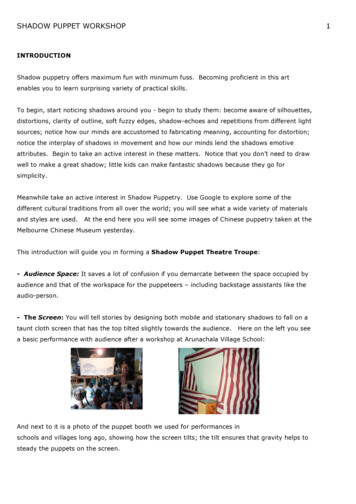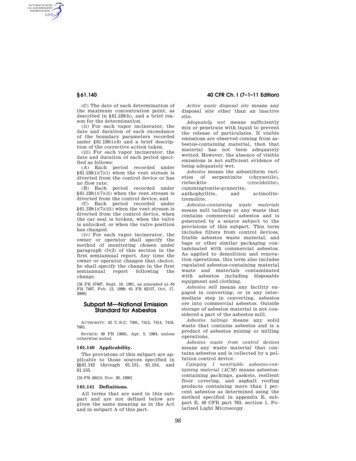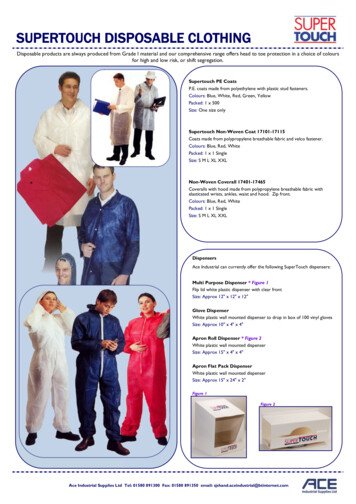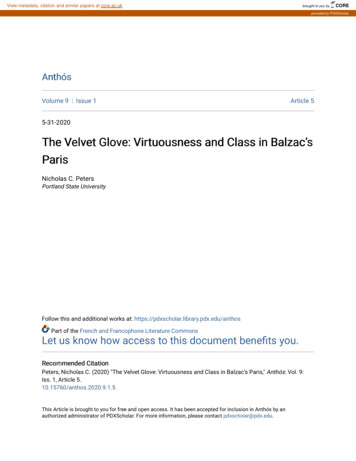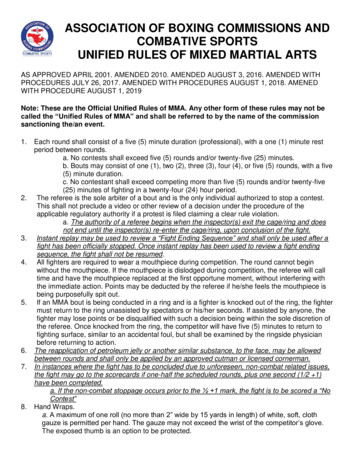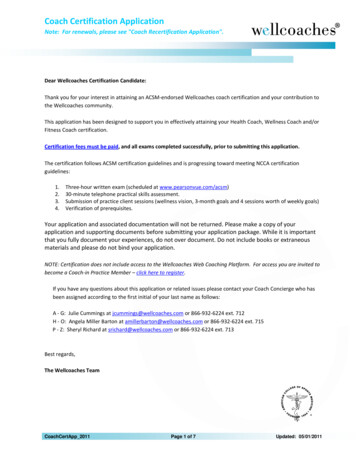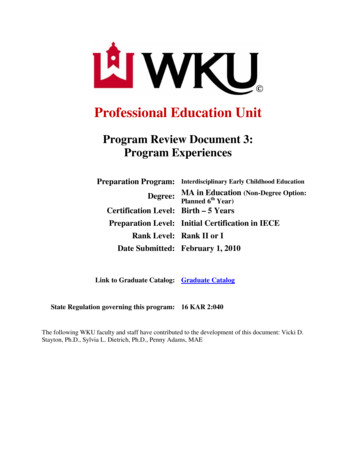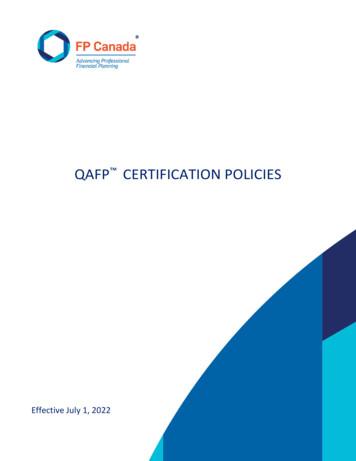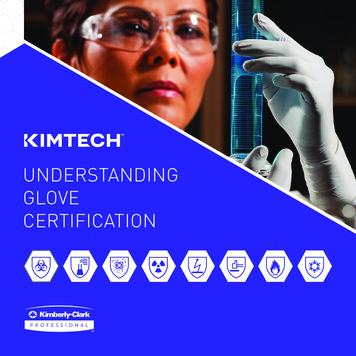
Transcription
UNDERSTANDINGGLOVECERTIFICATION
2
Understanding Glove CertificationSelect a glove with the appropriate level of EU/UK certification to addressyour application risk and performance requirements.3
Look for CE/UKCA CertificationA Notified Body/Approved Body gives CE/UKCA certification by providingan EU/UK certificate to PPE Cat III Gloves.To gain a CE/UKCA marking,safety protective gloves forsale in Europe/Great Britainmust meet a number ofstringent harmonized/designated standards.4
EU/UK Conformity Assessment*Category 1Category 2Category 3PPE designed to protectusers from minimal riskPPE that protectsfrom risks not includedin Cat. I or Cat. IIIPPE that protects fromrisks that may cause veryserious consequences suchas death or irreversibledamage to healthTechnical DocumentationQuality control systemfor the final productType ExaminationDeclaration of Conformitynnnn* per PPE Regulation (EU) 2016/425 and PPE Regulation (EU) 2016/425 as brought in the UK law and amended.5
PPE Category III GlovesProtecting against risks that may cause very serious consequences(death or irreversible damage).nnnnLook for a CE /UKCA symbol followed by thenotified body/approved body numberThis means that the manufacturing facility is audited and certified and atechnical documentation must be completed and submitted for EU/UKCAType Examination to a Notified Boby/Approved Body.6
Personal ProtectionPPE Category III gloves are a minimumrequirement for personal protection inapplications where there is exposure tochemicals or micro-organisms. It doesnot mean protection against allchemicals and micro-organisms. Assessthe risk and refer to glove performancedata for EN374-1 and -5 test standards.Non-Sterile Medical Gloves areconsidered as Class I Medical Deviceunder the MDR (EU) 2017/745 and areself-certified. Intended use is forpatient protection and other medicalapplications. This certification providesno standards for chemical ormicro-organism protection.Category III0123UKCA 0168Must pass EU/UKCA type examinationby notified body/approved body. PPEthat protects from risks that may causevery serious consequences such asdeath or irreversible damage to health.Provides protection againstmicro-organisms and chemicals.For personal protection in highrisk applicationsMedical DeviceRegulation Gloves EN455Are SELF Certified.Not submitted or EU typeexamination. Object is careof the patient. For Patientprotection*KimtechTM gloves are only certified as Personal Protective Equipment underthe PPE Regulation (EU) 2016/425.7
EN STANDARDS8
EN ISO 21420Describing general standards for protective gloves:› Innocuousness› Size› Dexterity› Package marking› Instructions for use9
EN ISO 374-1Terminology and performance requirementsfor chemical risksThis standard stipulates requirements forPermeation, Penetration and Degradation forprotective gloves intended to protect the usersagainst dangerous substances.Gloves will be categorised into three types:Type A, Type B or Type C, based on theirchemical permeation performance againstan extended list of chemical, which hasincreased from 12 to 18 :EN ISO 374-1Type AiUVWXYZEN ISO 374-1Type BiXYZEN ISO 374-1Type Ci› Type A : 6 chemicals tested with a min breakthrough time 30 min› Type B : 3 chemicals tested with a min breakthrough time 30 min› Type C : 1 chemical tested with a min breakthrough time 10 min› The degradation rate according to EN 374-4 will be reported with thechemical permeation data10
Product Class According to EN ISO 374-1, gloves are classified as:Based on performance level in Type A, B or CList of test chemicalsCODE LETTERCHEMICALCAS NUMBERCLASSAMethanol67-56-1Primary trile compoundDDichloromethane75-09-2Chlorinated hydrocarbonECarbon disulphide75-15-0Sulphur containing organic compoundFToluene108-88-3Aromatic ran109-99-9Heterocyclic and either compoundIEthyl acetate141-78-6EsterJn-Heptane142-82-5Saturated hydrocarbonKSodium hydroxide 40%1310-73-2Inorganic baseLSulphuric acid 696%7664-93-9Inorganic mineral acid, oxidisingMNitric acid 65%7697-37-2Inorganic mineral acid, oxidisingNAcetic acid 99%64-19-7Orgain acidOAmmonium hydroxide 25%1336-21-6Organic basePHydrogen peroxide 30%7722-84-1PeroxideSHydroflouric acid 40%7664-39-3Inorganic mineral acidTFormaldehyde 37%50-00-0AldehydeEN 16523-1 Determination of material resistance to permeation by chemicals Part 1: Permeation by potentially hazardous liquid chemicals under conditions of continuous contact11
EN ISO 374-5Protection against Micro-organismsEN ISO 374-5 specifies the requirements and testmethods for protective gloves intended to protectthe user against micro-organisms.Hand Protection - Micro-organisms hazard protectionEN ISO 374-2OldStandardNewStandard Level 2EN374-2:2003 Micro-organism hazardprotection against micro-organism,Level 3 - AQL 0.65 / Level 2 AQL 1.5 Test:water-tightness, ISO2859 sampling by lot.12EN ISO 374-5VIRUSFor protection against bacteria and fungia penetration test is required usingEN ISO 374-2. For protection againstviruses, compliance to ISO 16604(method B) standard if necessary.
EN ISO 374-4Determination of resistance to degradation by chemicalsThe resistance of a protective glove material to degradation by a liquidchemical is determined by measuring the puncture resistance change ofthe glove material after a continuous contact with the external surfacewith the challenge test chemical.The results are expressed in % change in puncture resistance beforeand after.Degradation results are reported beside each permeation breakthroughtime data point as shown below:Degradation TestEN ISO 374-4Permeation Test EN 16523-1EN ChemicalBreakthrough Time (min)PerformanceLevelPerformance Level %Na0H, 40% 480Class 6-1513
EN 421Protection from Radioactive Particle ContaminationTo protect from radioactive contamination, the glovehas to be:› Liquid proof and needs to pass the penetration testdefined in EN ISO 374-2› Needs to reach at least level 1 for one of the fivemechanical properties described in EN 388› For use in containment enclosures the glove mustalso pass a specific air pressure leak test› Materials may be modelled by their behaviour toozone cracking. This test is optional and can beused as an aid to selecting glovesProtection from Ionising RadiationTo protect from ionising radiation, the glove has tocontain a certain amount of lead or equivalent metal,quoted as lead equivalence. This lead equivalence ismarked on each glove.14
EN 16350Electrostatic PropertiesFor protective gloves that are intended to be wornin areas where flammable or explosive risks existor might be present, the electrostatic propertiesshall be tested according to the test methoddescribed in EN 16350.For gloves meeting the requirement in EN 16350,the corresponding pictogram can be applied.If the surface electrostatic properties or chargedecay need to be determined, EN 1149-1 orEN 1149-3 should be used to determine furtherelectrostatic properties of the gloves. Thecorresponding test results may be reported inthe information supplied by the manufacturer butcannot be used to apply the pictogram.15
EN 388Mechanical ProtectionThis European Standard specifies requirementsand corresponding marking for protectivegloves against mechanical risks.4 1 0 1 X› Abrasion› Cut protection via EN ISO 13997› Impact Protection via EN 13594› New Marking-6 protection levels instead of 4,including a “P” code in case of impact protectionIMPACT(P Achieved)DM CUT (Levels A - F) ( Via EN ISO 13997) ABRASION (Levels 1-4)Level A - Light DutyLevel B - Medium DutyLevel C - Medium DutyLevel D - Heavy DutyLevel E - Heavy DutyLevel F - Heavy DutyCoup CUT (Levels 1-5)TEAR (Levels 1-4)PUNCTURE (Levels 1-4)TDM CUT (Levels A - F)(Via EN ISO 13997)Level of Performance of Materials Tested With EN ISO 1399716Performance LevelLevel ALevel BLevel CLevel DLevel ELevel FTDM: Cut resitence (N)2510152230
EN 407EN 407Thermal HazardsThis standard specifies demands and testmethods for protective gloves that shallprotect against heat and/or fire. Thenumbers given besides the pictogramindicates the gloves performance for eachtest in the standard. The higher number thebetter performance level.1 2 3 4 5 61. Fire properties of the material2. Contact heat3. Convective heat4. Radiant heat5. Small splashes of molten metal6. Large quantities of molten metal17
EN 511Protection Against ColdThis standard measure how well the glove canwithstand both convective cold and contact cold.In addition, water permeation is tested after 30minutes.› The first figure shows how well the glove protectsagainst convective cold (performance level 0-4)› The second figure shows how well the gloveprotects against contact cold (performance level 0-4)› The third figure shows the glove protection againstwater penetration (performance 0 or 1 where 0indicates “water penetration after 30 minutes” and1 indicates “no water penetration after 30 minutes”)Protection against convective coldProtection against contact coldProtection against water penetration18EN 5111 2 1
Kimtech Laboratory Gloves –Chemical Risk selection guideChemicalProtectionEN ISO374-1BiohazardProtectionEN ISO 374-5AQLGloveLengthPrizm Xtra Multi LayeredNeoprene-NitrileGlovesXS XLType A(JKLMPT)Virus0.6530cm99221 99225Prizm Multi LayeredNeoprene-NitrileGlovesXS XLType A(JKLMPT)Virus0.6524-25cm9761097614Purple Nitrile Xtra GlovesXS XLType B(JKT)Virus0.6530cm90625 -90629Purple Nitrile GlovesXS - XLType B (JKT)Virus0.6524-25cm62880 62884Opal Nitrile GlovesXS - XLType B (KPT)Virus1.524cm99210 -99214Sterling NitrileGlovesXS - XLType CVirus0.6524-25cm99850 -99854Green Nitrile GlovesXS - XLType CVirus0.6524-25cm-Moderatechemicalsplash 99251 99255ChemicalHIGHESTChemotherapy& High RiskApplicationsSizingCHEMICAL PROTECTION LEVELDescriptionLOWESTLow risk Light splashProductCode19
Choosing the right gloveIt is important to select gloves with theappropriate level of EU certification but don’tforget to consider:› Lower skin allergy risk - look for syntheticmaterials such as nitrile instead of latex› Prevent skin irritation - look for NonDetectable (ND) chemical accelerator levels› Reduce contamination risk - ask for trenddata around cleanliness› Ensure correct size and fit› Select features for performance - grip,length, dexterity, comfort, insulationPOWDER CONTAINSFREEPOWDERPowder free or not?LATEXFREENon-latex or not?2Single UseOnly20LATEXRecyclable
Chemical Permeation Data› Visit www.kimtech.eu, fromthe top menu select resourcesand then chemical permeation› Select up to 4 gloves to compare.Select either breakthrough timesin minutes, or classification› Submit and download your PDF› EU and UK Declarations of Conformity can bedownloaded on each product detail pagefrom www.kimtech.eu21
For more information visit www.kimtech.euFor technical assistance contact usat kimtech.support@kcc.com / Trademarks of Kimberly-Clark Worldwide, Inc. or its affiliates. KCWW. The colour Purple and Purple Nitrile ,the colour Grey and Sterling are trademarks of Owens & Minor, Inc. or its affiliates and used under license.Publication code: 4999.01 EN 04.22
90625 -90629 Purple Nitrile Gloves XS - XL Type B (JKT) Virus 0.65 24-25cm 62880 - 62884 Opal Nitrile Gloves XS - XL Type B (KPT) Virus 1.5 24cm 99210 -99214 Sterling Nitrile Gloves XS - XL Type C Virus 0.65 24-25cm 99850 -99854 Green Nitrile Gloves XS - XL Type C Virus 0.65 24-25cm HIGHEST Chemotherapy & High Risk Applications

